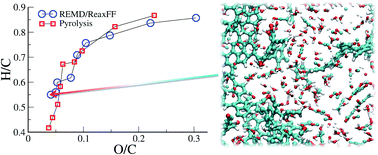From cellulose to kerogen: molecular simulation of a geological process†
Abstract
The process by which organic matter decomposes deep underground to form petroleum and its underlying kerogen matrix has so far remained a no man’s land to theoreticians, largely because of the geological (Myears) timescale associated with the process. Using reactive molecular dynamics and an accelerated simulation framework, the replica exchange molecular dynamics method, we simulate the full transformation of cellulose into kerogen and its associated fluid phase under prevailing geological conditions. We observe in sequence the fragmentation of the cellulose crystal and production of water, the development of an unsaturated aliphatic macromolecular phase and its aromatization. The composition of the solid residue along the maturation pathway strictly follows what is observed for natural type III kerogen and for artificially matured samples under confined conditions. After expulsion of the fluid phase, the obtained microporous kerogen possesses the structure, texture, density, porosity and stiffness observed for mature type III kerogen and a microporous carbon obtained by saccharose pyrolysis at low temperature. As expected for this variety of precursor, the main resulting hydrocarbon is methane. The present work thus demonstrates that molecular simulations can now be used to assess, almost quantitatively, such complex chemical processes as petrogenesis in fossil reservoirs and, more generally, the possible conversion of any natural product into bio-sourced materials and/or fuel.



 Please wait while we load your content...
Please wait while we load your content...